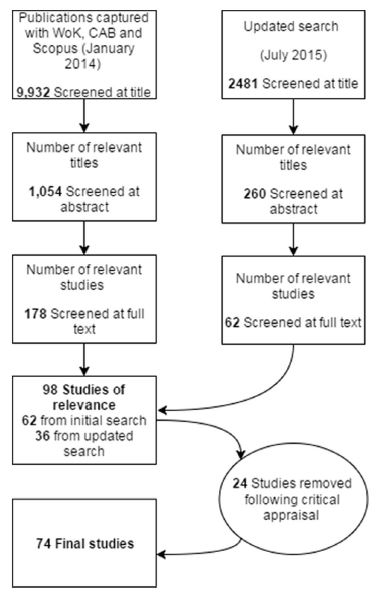Last week, I finally decided on my dissertation topic. The tentative title of my study is: “The contribution of agroforestry to food security in West Java, Indonesia: A review of the evidence.”
It took many discussions and a lot of deliberation to decide on a study that was feasible in the short time that I have, relevant to my research interests, and valuable to CIFOR’s Sustainable Landscapes and Food Systems research unit – and the scientific community in general.

As the study is a literature review, we needed to decide on the review methodology. I used three databases (Web of Science, Scopus, and CAB Direct) to scope the available literature on the subject. I used different search terms (creating various search strings), and documented all of the results. I varied the search strings by adding or removing different agroforestry and geographical terminology. Generally speaking, the more variations on agroforestry terminology and the larger the geographic area, the more results the search strings returned.
The scoping revealed that a systematic review of the contribution of agroforestry to food security in West Java was possible within my time frame. A review becomes systematic if it has a clear, testable research question, and uses predetermined, systematic methodology to find relevant studies, assess their quality, and summarise or analyse the data of interest within these studies.
Now that I have decided on my search string, and found all the literature I can within the methodology of my systematic literature review, the next step is screening the literature for relevance and presence of data on yield, income, and agroforestry markets. Foli et al. (2014) and Reed et al. (2017) describe this screening process well (see Figure 1).
The systematic review process can be tedious, but they are valuable sources of collated data which can provide an concise overview of a topic, helping researchers to determine future research trends, and help policy makers to develop policies and make decisions.
References:
Foli, S., Reed, J., Clendenning, J., Petrokofsky, G., Padoch, C., Sunderland, T., 2014. To what extent does the presence of forests and trees contribute to food production in humid and dry forest landscapes?: a systematic review protocol. Environmental Evidence 3, 15.
Khan, K.S., Kunz, R., Kleijnen, J., Antes, G., 2003. Five steps to conducting a systematic review. Journal of the Royal Society of Medicine 96, 118-121.
Reed, J., van Vianen, J., Foli, S., Clendenning, J., Yang, K., MacDonald, M., Petrokofsky, G., Padoch, C., Sunderland, T., 2017. Trees for life: The ecosystem service contribution of trees to food production and livelihoods in the tropics. Forest Policy and Economics. http://dx.doi.org/10.1016/j.forpol.2017.01.012
